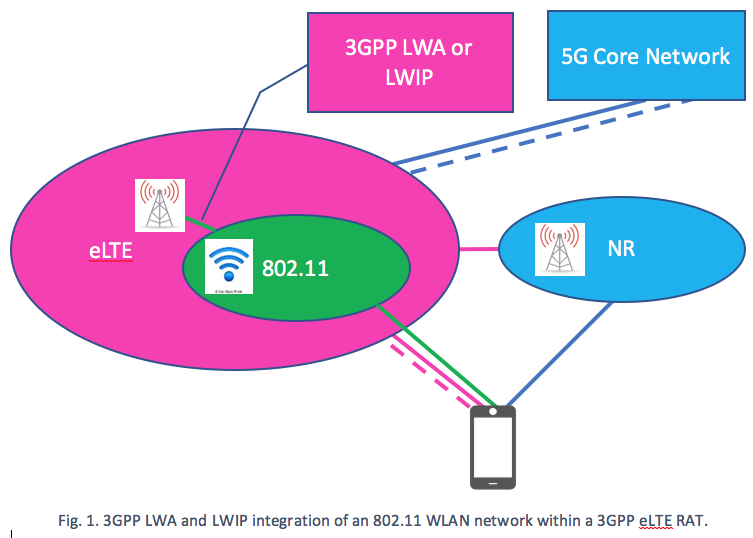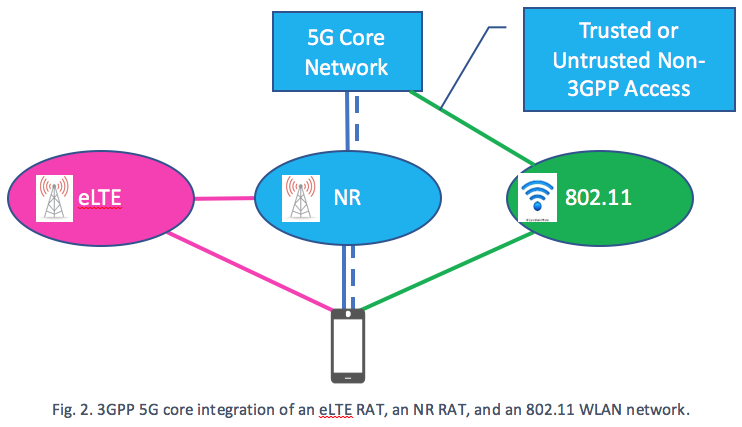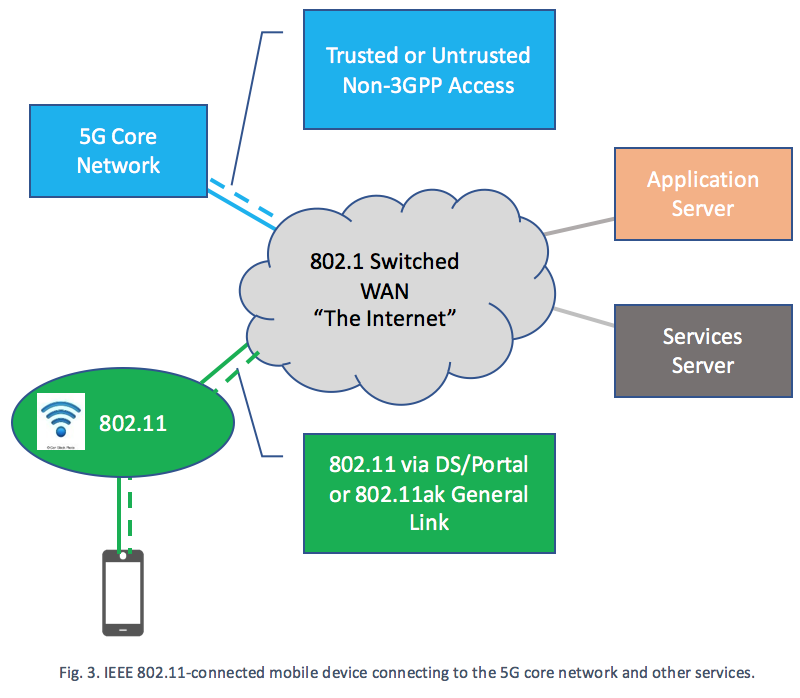This article provides some high-level architectural descriptions of a fifth-generation (5G) cellular network that contains an IEEE 802.11 wireless local area network (WLAN). There is no agreed-upon definition of what a 5G network is as various stakeholders have different definitions based on their perspectives. The Third Generation Partnership Project (3GPP), the cellular standardization community, defines 5G to mean the next generation of cellular technology (3GPP Release 14, 15, and 16 specifications). These releases are the specifications that 3GPP is developing to address the International Telecommunications Union Radiocommunication Sector’s (ITU-R) International Mobile Telecommunications 2020 (IMT-2020) requirements [1]. The general IEEE community has embraced a definition of 5G to be the advanced/next-generation communication technologies that will contribute to defining next-generation networks [2]. To the cellular marketing community and the general public, it has been defined as the next advance in communications technology, following 4G (Long Term Evolution, LTE), which will “improve” everyone’s life. For this article, the 5G cellular network is understood to be the next generation network that will provide communications services for mobile devices: smartphones, tablets, and laptops. To connect these devices, it is assumed that the network will need to include multiple radio access technologies (RATs) such as IEEE 802.11-based WLAN (802.11) [9], commercially known as Wi-Fi and WiGig, and various 3GPP-defined wireless cellular technologies such as Enhanced Long-Term Evolution (eLTE) and New Radio (NR).
Please note that the example network architectures provided in this article are used to illustrate different ways of implementing an integrated 5G network. This set of examples is not intended to be complete, and actual implementations will vary as they will be customized to the network operator’s business and customer needs.
Many user applications and services need to have connectivity between the mobile device and application or service servers in order to function. Network technologies and radio access technologies (RATs) provide this connectivity by defining data bearers for these applications and services to use. The architectures described below manage and assign RAT resources to these bearers differently and, therefore, may have different efficiencies, flexibilities, and dynamic performances. However, they all attempt to achieve the same end goal of providing data bearers to meet user needs.
It is also assumed that the 5G network will provide data bearers that will connect mobile devices to various applications and services. These data bearers will use a RAT or multiple RATs connected to a 5G core network or a general wide area network (WAN) to provide these connections. The architectures shown are consistent with the planned 3GPP Release 15 specifications (June 2018) [1], [3], and [4]. To enhance the connectivity options of the 5G cellular network an IEEE 802.11 based WLAN is added. The inclusion of an IEEE 802.11-based WLAN is currently a reality in many existing 4G cellular networks as Wi-Fi-based internet browsing, video streaming, and Wi-Fi calling are usually available to users with most mobile devices. It is also assumed that the 3GPP user equipment (UE) shown in the diagrams can support multiple RATs simultaneously (e.g., eLTE, NR, and Wi-Fi).
- The first architecture connects the mobile device to the 5G core network by any or all of the three available RATs: eLTE, NR, or 802.11, as shown in Fig. 1. The 5G core network provides connectivity to application and service servers. In this architecture, the 5G core network is connected through the eLTE RAT, which then manages the data flows (solid line connections) over all the RATs: eLTE, NR, and 802.11. The eLTE Node B performs the bearer management to route the data to and from the mobile device through a RAT or combination of RATs. For data being sent via the 802.11 RAT the Node B can use the 3GPP specified LTE-WAN Aggregation (LWA) [5], [6] or LTE WLAN Radio Level Integration with IPsec Tunnel (LWIP) [4], [5] capabilities. Routing of data via the NR RAT is part of the planned 3GPP Release 15 specifications [1]. This architecture allows the eLTE Node B to make near “real time” splitting and routing decisions based on link performance of the available RATs. All non-access stratum (NAS) control signaling (dashed connection) is sent over the eLTE RAT. Note that there have been some discussions regarding 3GPP LWA/LWIP type aggregation for 3GPP NR. However, at this time, there is no 3GPP activity to create such a specification, though it may be considered in the future by 3GPP Technical Specifications Group (TSG) on Radio Access Network (RAN) [3]. If this 3GPP NR capability is specified, it will enable an alternate architecture where the NR Node B manages the aggradation of the RATs and provides the NAS control signaling. This alternative architecture will connect the 5G core network directly to the NR RAT (and not the eLTE RAT).

- 3GPP TSG, Service and Systems Aspects (SA) is currently working to define a set of specifications for the 3GPP 5G system that will specify a common interface between the access network and the core network. This interface will integrate both 3GPP and non-3GPP access types [4], [8]. In this architecture, the 802.11 RAT is connected directly to the 3GPP 5G core network via a trusted or untrusted non-3GPP interface. The trusted or untrusted non-3GPP interface is currently being specified by 3GPP TSG SA [4]. As shown in Fig. 2, data bearers are routed or split by the core network over any or all the available RATs: eLTE, NT, and/or 802.11. This architecture allows the core network to optimize the data flows to and from UEs. Control is shown to be provided via the NR access network, which is one probable configuration as the control signaling routing is also configurable by the 5G core network.

- In the third basic architecture, shown in Fig. 3, a mobile device is connected through a single RAT, 802.11, to an 802.1 switched WAN that provides network connections to an application server, a service server, and a 5G core network (which may provide connectivity to additional application and service servers, not shown). The 802.11 wireless network can be connected to the WAN via a traditional 802.11 distribution service (DS) and a portal combination [9] or by a direct connection to an IEEE Std 802.1Q bridge [11], [12] via an 802.11 general link [10]. To allow applications and services accessible though the 5G core network, a connection to the 5G core network is provided via 3GPP-defined untrusted or trusted non-3GPP access [4], [8]. The bearers in this architecture are managed by the WAN management of packet flows through the network and/or the 3GPP 5G core network. Note that most UEs currently use a variation of this architecture to browse the internet, stream videos, and provide Wi-Fi calling when they are connected to the internet via Wi-Fi.

The high-level architectures described above provide an overview as to how 5G networks may be configured to leverage existing and future IEEE 802.11 WLAN RATs with existing LTE RATs and future eLTE/NR RATs so that the 5G goal of an always-on, high-speed wireless access network to support user applications and services on mobile devices can be met. To achieve this goal, it is essential to use both current and future deployed RATs and networks. Given the large and ever-growing number of installed IEEE 802.11 WLANs and the almost universal availability of 802.11 RAT in mobile devices, it is desirable to leverage these RATs to enable the deployment of 5G networks in a timely and cost-effective manner.
References
- 3GPP 5G, S02-1_3GPP 20IMT-2020, “3GPP activity towards IMT-2020” – Giovanni Romano (3GPP RAN ITU-R Ad-Hoc) – 4 October 2017
- https://5g.ieee.org/ “IEEE 5G Web Page”
- 11-17/0444r0 – Liaison statement from 3GPP RAN on Radio-Level Integration – Adrian Stephens (Intel Corporation) 802.11 Chair – Liaison from 3GPP RAN (RP-170853) – 3 March 2017
- 11-17/0903r0 – Liaison statement from 3GPP TSG SA on WLAN Integration – Adrian Stephens (Intel Corporation) 802.11 Chair – Liaison from 3GPP TSG SA (SP-170853) –13 June 2017
- 11-16/0351r1 – “Liaison from 3GPP on LWA and LWIP” – Richard Burbidge (Intel Corporation) – 14 March 2016 (Note: This document contains multiple 3GPP references.)
- 11-16/0449r0 – “3GPP activities on 5G and relationship with non-3GPP technologies” – Richard Burbidge (Intel Corporation), Philippe Reininger (Huawei) – 15 March 2016
- 11-15/1376r2 – “Update on 3GPP RAN3 Multi-RAT joint coordination” – Filip Mestanov (Ericsson) – 11 November 2015
- 11-17/1064r0 – “Overview of 3GPP SA Next Generation System Documents Related to Non-3GPP Access to the 5G Core Network” – Joseph Levy (InterDigital) – 5 July 2017
- IEEE Std 802.11-2016 – Part 11: Wireless LAN Medium Access Control (MAC) and Physical Layer (PHY) Specifications – December 2016
- IEEE Draft Std P802.11ak_D6.0 – https://www.techstreet.com/ieee/standards/ieee-p802-11ak?product_id=1949130 Draft Standard Telecommunications and information exchange between systems – Local and metropolitan area networks Part 11: Wireless LAN Medium Access Control (MAC) and Physical Layer (PHY) Specifications, Amendment 4: Enhancements for Transit Links Within 8 Bridged Networks, December 2017
- IEEE Std 802.1AC-2016, Media Access Control (MAC) Service Definition – December 2016
- IEEE Std 802.1Qbz-2016, Bridges and Bridged Networks— Amendment 27: Enhancements to Bridging of IEEE 802.11 Media – June 2016
Joseph Levy is with InterDigital, Inc. He is Chair of IEEE 802.11 AANI.
